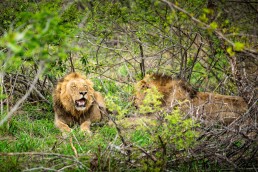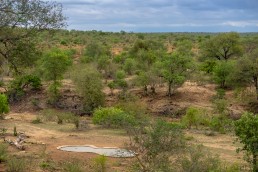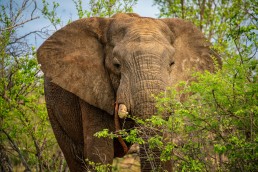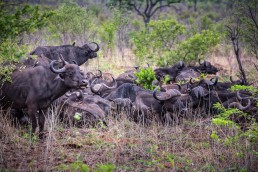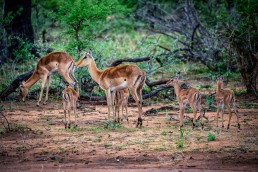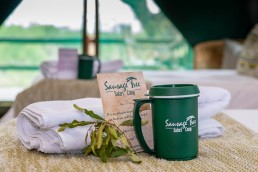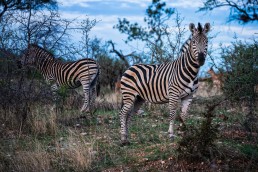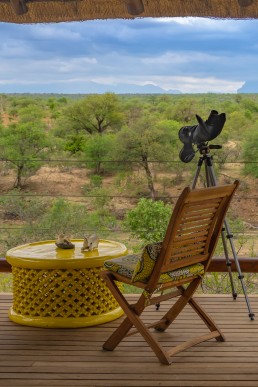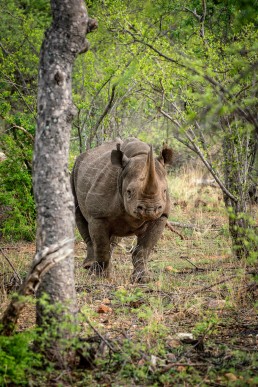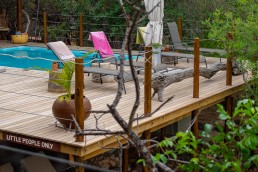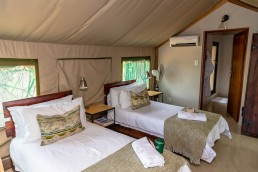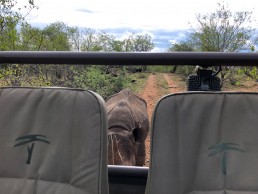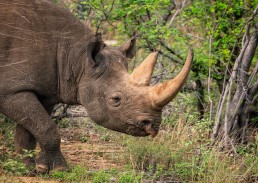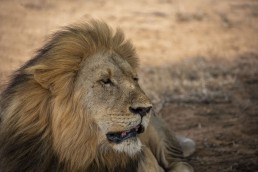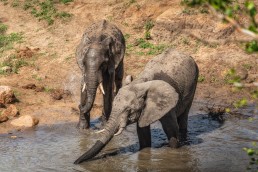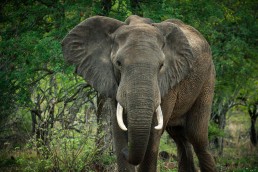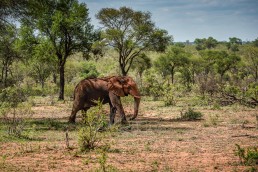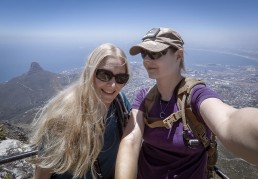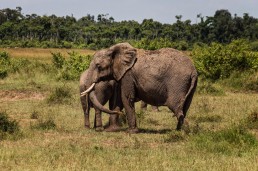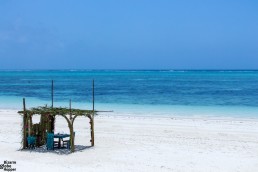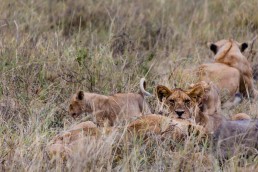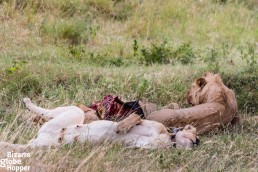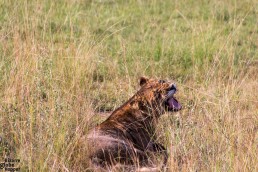When planning a South African safari, the first question is often: Kruger or Greater Kruger National Park? What are the key differences between the public sector of Kruger National Park and the private reserves belonging to the Greater Kruger National Park, when it comes to safari experience as a whole, price, and the authenticity? Let’s compare safaris in Greater Kruger vs. Kruger National Park – and find the best safari destination for you!
If you’re planning your first safari in South Africa, the terms might sound confusing. Thus, we’ll shed a little light into the division of Kruger National Park and Greater Kruger National Park at first, and then compare them to the surrounding fenced private reserves.
This article has been last updated in March 2024. We’ve been traveling extensively and full-time in the Southern and Eastern Africa for the last 5 years (and before that yearly on guided safaris) and have visited both Kruger National Park and the Greater Kruger several times. We’ve actually spent months inside Kruger at a time, many times. Thus we like to see ourselves fit for the argumentation and this comparison between Kruger and Greater Kruger.
What is Greater Kruger National Park and How It Differs from Kruger National Park?
Kruger National Park is one of the most famous and largest national parks in Africa. Making things a bit confusing, Kruger National Park is often separated from Greater Kruger National Park, although sometimes also the latter is called Kruger National Park.
The term Kruger National Park (KNP) means the public sector of (Greater) Kruger National Park, which is owned and run by the South African government (SANParks). Kruger National Park covers around 20 000 hectares of protected land.
Greater Kruger National Parks (GKNP) refers to the privately-owned reserves bordering the public sector of Kruger National Park in which wildlife roams freely. There are no fences between Kruger and the private reserves belonging to the Greater Kruger National Park, hence the name. These over 20 private reserves add up to 180 000 hectares to the nature reserve, making it one of the largest game reserves in the world. You could think of Greater Kruger as a buffer zone between the core area of the national park and the nearby settlements, or as an expansion of the Kruger Park.
We’ll compare the safari experience in Kruger and Greater Kruger NP in detail later on, but here are the key differences in short. You can see the same animals in Kruger and Greater Kruger, as there are no fences between the reserves.
Safari in Greater Kruger vs. Kruger National Park: The Main Differences
- Self-drives in Kruger NP vs. guided game drives in Greater Kruger NP
- Crowded wildlife sightings in Kruger NP vs. private sightings in Greater Kruger NP
- Big government-owned lodges in Kruger NP vs. exclusive private camps in Greater Kruger NP
- Affordable camping and lodges in Kruger NP vs. luxury lodges in Greater Kruger NP
- Fenced camps in Kruger NP vs. fenced and unfenced camps in Greater Kruger NP
- Game drives inside the whole Kruger National Park (20 000 hectares) vs. smaller designated game drive areas in Greater Kruger NP (depending on the reserve and your camp/lodge)
What’s the Difference Between Greater Kruger National Park and Fenced Private Reserves – and Why Greater Kruger is Better for Safari?
Greater Kruger National Park is one of the biggest game reserves in the world. With 2 million hectares – or 20 000 square kilometers – Greater Kruger National is huge and has more large mammal species than any other African national park (there are 148 mammal species in Kruger National Park).
Only in large game reserves like Greater Kruger National Park or Serengeti, you can expect to see large herds of prey animals, such as wildebeest and zebras, and huge concentration of predators, such as tens of lion prides.
There are many privately owned, smaller fenced reserves also nearby Greater Kruger National Park. The main difference between small fenced private reserves and Greater Kruger is the amount of predators: you cannot have many big cats in a small fenced reserve or your predator-prey balance would suffer (imagine a small reserve full of hungry lions and no buffalos, zebras, or impalas to keep them fed).
Why Kruger National Park & Greater Kruger are together the Number One Safari Destination in South Africa
- Regular Big 5 sightings and ease of finding wildlife (also on self-drive safaris in Kruger NP)
- Steady predator populations and huge herds of prey animals, such as buffalos, gnus, zebras, impalas and other antelopes
- Good roads inside the park (main roads in Kruger NP are tar roads, also gravel roads inside the park are well maintained; in private reserves, you’ll do game drives in camps’ 4×4 vehicles, so roads don’t matter that much)
- Easy access: Four airports with daily flights and affordable shuttle transports from nearby big cities (Johannesburg is usually the best starting point)
- The most extensive array of budget, mid-range and luxury lodges in Southern Africa
- Campsites and picnic spots all around Kruger National Park – and in GKNP you can stop anywhere for a luxury picnic in the wilderness or have a bush dinner organised by your camp
- South Africa’s largest and most important national park
10 REASONS TO CHOOSE GREATER KRUGER NATIONAL PARK VS. KRUGER NATIONAL PARK
The title tells our stance: we recommend Greater Kruger National Park over the crowded and commercial Kruger National Park – especially for the first-time safari. We’ve explored both options thoroughly during our last five years in Africa: we’ve also spent many months camping and self-driving inside Kruger National Park, and we love Kruger, but we still recommend Greater Kruger for anyone looking for the best possible safari in South Africa. Why? Well, the answer is long, so we’ll elaborate our opinion below through 10 reasons to pick Greater Kruger over Kruger National Park.
1. No Self-Drives in Greater Kruger National Park – It’s a Bliss!
Lack of self-driving tourists is one of the best selling points for private reserves of the Greater Kruger National Park. When you’ve visited Kruger National Park, you’ll understand why. The sheer volume of visitors, and especially nonchalant self-drivers breaking the rules all the time, makes visiting Kruger National park a rather chaotic and stressful experience. I’ll discuss this more in-depth in the next chapter.
Is the Comparison of Kruger and Greater Kruger National Park All About Guided Safaris vs. Self-Drive Safaris?
Many tourists see the decision between Kruger National Park and the private reserves as choosing between self-drive or guided safari, but there’s much more in the game here.
Let’s start from the simple rules. Self-drive safaris are not allowed in the private reserves of the Greater Kruger National Park. So, if you want to do independent self-drives, Kruger National Park is your only option. In the Greater Kruger reserves, private cars are only allowed to drive between the gates and lodges.
Guided Safari in Kruger National Park – Yes, It’s Possible!
SanParks offers game drives in most of the camps in Kruger, so you can book affordable guided morning, afternoon or full-day game drives even if you’re otherwise self-driving. Please note that SanParks’ game drives are group tours and they’re usually full: depending on the number of participants, the driver guide takes a smaller safari vehicle (like Toyota Hilux) for up to 6 guests or even a big truck for up around 20 participants. Although the ranger guides are trained and qualified field guides, they are more rangers than safari guides and the level of guiding doesn’t usually match the dedication, art and craft of guiding you can find in many private game reserves. You can check out and book SanParks’ game drives in Kruger on their website here.
Also many tour operators offer guided safaris in Kruger National Park: you can book either a day trip or a multi-day safari in Kruger National Park. It’s even possible to stay outside the gates of Kruger and explore the national park on long full-day game drives.
So, you can definitely do Kruger National Park safari with a trained wildlife guide and a driver, who will make sure that you’ll see as much wildlife as possible. Sometimes a guided Kruger day tour is combined with a Greater Kruger safari itinerary, too. You can also check out our experience on 3-day guided Kruger safari here.
2. Private Wildlife Watching with Professional Guides vs. Sharing the Sightings with Many Cars Lacking the Game-Viewing Etiquette
Private reserves of the Greater Kruger National Park limit the number of vehicles at each wildlife sighting. Many times, your car is the only one at a sighting – and there should never be more than one other car.
When professional guides are in charge, also the animals know that humans mean no harm, so they tolerate the open safari vehicles and let them approach them without changing their natural behavior. The safari experience gets better, smoother, and deeper. Wildlife photography gets easier, angles are better, and results more interesting.
The predator sightings inside Kruger National Park can be chaotic, noisy, and rather stressful (for tourists and animals alike). Unfortunately, in the public sector of Kruger National Park, many self-driving tourists don’t obey the rules and harass the animals – or other cars.
In Kruger proper, there can be easily over ten or twenty cars at one lion sighting, when you might need to wait for half an hour even to see the lion at a distance. We’ve left many lion sightings without even taking photos, as we would have needed to wait too long to get a decent shot. For a photographer, those kind of “mega sightings” turn into a nightmare: you can’t get the car properly positioned for good shots because off-roading is not allowed in Kruger NP and other cars are always on your way. You’ll only get frustrated because you miss the good frames and situations because of all the mayhem around you. Sometimes visiting Kruger feels like you’re in big zoo.
We’ve also seen outrageous attitudes, drivers shouting to each other at sightings and even hooting to get through (thus scaring off the animals), and people getting off the vehicles against the rules, causing dangerous situations. Please always adhere to the park rules and regulations and report the rule breakers (by calling to Kruger’s Emergency Call Centre, 013 735 4325).
In private reserves, self-drives are not allowed, which limits the number of cars on the roads and especially at the sightings. Many times it feels that your safari party is the only one exploring the vast wilderness. In bigger reserves or Greater Kruger, you can sometimes drive for hours without seeing other cars. That’s a proper African safari, if you ask us.
According to our experiences, wildlife sightings are always better in private reserves, as they are more serene and everyone respects the nature and animals. For us, that’s the true nature of African safari.
3. Offroading for the Best Wildlife Sightings vs. Staying on Marked Roads
Offroading is prohibited in Kruger National Park but allowed in the private reserves of Greater Kruger NP.
Offroading is a photographer’s best friend on a safari, as you can get closer to the wildlife and find the best angles to take photos (against the light, side light, backlight; facial shot, profile, action shot for a leopard descending a tree or a proper predator-prey chase; a photographer’s wish list can be endless and your guide can position the car according to your likings).
It’s also always exciting to leave the road behind to follow wildlife footprints deeper into the bush to track rhinos or big cats that you wouldn’t have been even able to see from the road. So if you see a lion with binoculars in Kruger NP, you cannot venture off-road to track it (like in Greater Kruger). In Kruger NP, you must stay on the roads and inside your vehicle.
Most lodges in private reserves use 4×4 open safari vehicles, where you can be closer to nature and its animals. The thrill of seeing the animals just beside the car without any physical boundaries never gets old!
4. Professional Safari Guides Fill You with Safari Knowledge and Can Find Animals That You Wouldn’t
A great safari guide makes all the difference, even if you’ve already been on countless African safaris like us. There’s always more to learn about wildlife behavior, little creatures, plants, even ants. Self-drives in Kruger can be epic fun, but nothing beats the educational aspect of a good guided game drive.
Professional wildlife guides are skilled in tracking down animals, which makes the safari experience much more profound. No matter how good you’d think you are in finding animals, trained safari guides are always better. We would have missed some of the best safari experiences in our lives if we had been driving in the bush on our own. And please note that by far we have been self-driving allover the national parks in Southern and Eastern Africa for the last five years!
Passionate safari guides in private reserves also love to tell you more about tracking and animal behavior, so you’ll start to see the surrounding bush in a different light. If the vervet monkeys are screaming, there might be a leopard nearby. If baboons go berserk, it’s usually a lion. Impalas and other antelopes snort when they notice a danger, be it a lion, leopard, wild dog, or hyena clan. Also zebras snort, but they also neigh and bark, different sounds signal different things. Bird warning calls reveal many many predators and some birds can also have a symbiotic relationship with them: for example, if you follow a honeyguide (bird), you might find one of our favorite predators, a honey badger!
5. Walking Safaris and Other Activities in the Wilderness
Private camps and lodges in Greater Kruger Park offer many exciting activities that are not available in Kruger NP. You can also usually also get private safaris, if you wish (in luxury lodges it can be a default not to mix guests in the same car).
Daily morning and evening game drives (also called sunrise and sunset drives) are usually included in the all-inclusive safari packages with a bush breakfast and sundowners with snacks. During the picnics, the guide will set up a table, and you can stretch your legs while enjoying the views (and sometimes distant wildlife sightings, for example, having morning coffee surrounded by a herd of elephants or zebras).
These exclusive picnic moments in the middle of wilderness make you feel like the only people inside the park. Sundowners in the bush are among the safari highlights, as you can admire passing animals with a cold drink in your hand while taking photos of the magical African sunsets.
Many camps in Greater Kruger National Park offer walking safaris that can be tailored into your interests (birds, plants, traditional bush medicines, elephants, etc), boat safaris (Olifants River in Balule Nature Reserve), visits to the nearby wildlife centers, hot air ballooning and micro flights, longer hikes, and cultural activities.
In Kruger National Park, self-drive safaris (and third-party guided safaris) are not allowed at sunrise, sunset, and after dark. The only option inside Kruger NP is to join guided sunrise, sunset, and night drives that are organized by SANParks and led by park rangers. Those drives are usually crowded, the rangers and park officials are not comparable to the guides in private reserves, and you’re not allowed to have breakfasts or sundowners out in the wilderness like in private reserves of Greater Kruger. Same goes with the walking safaris: you must book with SANParks and join their group activities.
6. Finding the Big Five in Peace vs. “Ferrari Safaris”
Kruger National Park offers unequaled diversity of wildlife and astonishing 20.000 hectares of protected land to track the animals – there are always predators and big game somewhere. However, with so much land to cover, game drives in Kruger National Park often become “ferrari safaris”, as the guides nickname them. It means that you will spend a lot of time driving on tar roads as fast as you can to get from one sighting to another.
Guides share wildlife sightings over radio, which means that after someone has found a lion, tens of cars race with each other towards the poor lion. At the sighting, not all guides follow the rules, blocking the animals from other vehicles. Many tourists forget the rules, as well, shouting “lion, lion” or otherwise scaring off the wildlife.
Many tourists spend only one day in Kruger National Park, thus their guides try to catch the whole Big Five within 5-8 hours of a guided full-day safari. It’s quite understandable that everyone wants to see the Big 5 at least once in a lifetime, but you might not want to use your own safari days driving like a crazy from a sightings to another and only spending a couple of minutes at each sighting to push forward to the next lion. Needless to say, ferrari safaris are not a great match for a photographer and they get old really fast for any nature lover.
So, bigger is not always better. Go for the quality, choose the private reserve (check the number 2 on our list) and maybe visit Kruger on a full-day safari.
7. Costs: Is Greater Kruger Safari Always (Much) More Expensive Than Kruger National Park Safari?
We want to bust the common myth: private reserve safaris are not necessarily more expensive than self-drives or guided safaris in Kruger National Park. Of course, private reserves offer luxury safaris, but there are also affordable lodges ranging from “lower luxury” to mid-range and even budget options.
To be honest, most lodges in Greater Kruger reserves are mid-range or luxury. Still, I’d advise comparing the costs of Greater Kruger all-inclusive safari and that of Kruger National Park (which comes with a rental vehicle or separately paid guided activities twice a day).
In Kruger National Park, you pay for the daily national park entry and conservation fee, daily meals, accommodation, and guided morning and night game drives if you’re interested to see the animals at prime time when they are most active. The costs quickly add up, although the price level in public rest camps is generally lower than in private reserves.
In private reserves of the Greater Kruger National Park, most camps have all-inclusive prices that cover all the game drives (morning and afternoon game drive, the latter can be extended into a night drive, too), additional activities depending on the camp (walking safaris or cultural tours), all meals (breakfast, lunch, multi-course dinner, afternoon tea with cake or snacks, bush picnics on game drives).
How to Get the Best Price for Greater Kruger Safari?
In general, lesser-known reserves of Greater Kruger National Park offer better value for money. For example, pick Balule Nature Reserve over Sabi Sand to get a more affordable safari.
Look at the map: Kruger National Park is surrounded with small private reserves. Search online for more info about the reserves and lodges, check reviews on TripAdvisor, and ask the right questions to find out if it’s your dream safari or not (check “how to find the right safari lodge” section below).
Go off-season: high season means highest prices. Shoulder and off-seasons bring tempting offers even to well-known reserves and luxury lodges. Note that most of the camps usually call the rainy season more commercially “the green season” or summer season. It’s not a bad time to visit Kruger or Greater Kruger: landscape is beautiful, migrant birds arrive, and you can still find great wildlife sightings, too (although it’s harder to spot animals through the lush foliage).
Check out our tented camp recommendation, Sausage Tree Camp, for the best price-quality ratio in Greater Kruger!
8. Seclusion: Private Safari Camps vs. Busy SANParks Rest Camps and Lodges
SANParks operated rest camps inside Kruger National Park are crowded, noisy, and busy. The atmosphere is like a summer camp for adults. Some of the bigger rest camps are like little villages with their own filling stations, restaurants, and budget-friendly accommodation options from a campsite to tented camps, bungalows, and budget rooms.
Imagine big buses offloading crowds for coffee breaks, lunch, and dinner. Then picture hundreds of people staying in the camp through the night, either camping or in numerous bungalows, and suites, while some are partying and barbecuing and some (like us) prefer to sleep. The pools in rest camps are crowded, restaurants serve mostly bland (mainly buffet) meals, and customer service is rather tired, as are the facilities.
In private reserves, the lodges and camps are generally beautifully laid out in a tranquil setting. Many camps don’t have fences (see the next argument), which allows wildlife like elephants, zebras, impalas, and wildebeest to pass your accommodation. The whole safari experience is crafted around enjoying the wilderness and wildlife, like it should be.
9. Unfenced Camps = Wildlife in the Camps
Unfenced camps are the best part of staying in the private reserves of Greater Kruger Park: animals can roam freely through the camps. Depending on the camp and wildlife populations around it, you could see (and meet) zebras, impalas, wildebeest and other hooves, elephants, and even big cats within the camp’s boundaries.
For us, unfenced camps offer the real safari experience. It’s always thrilling to share the camp with wild animals. We’ve been stuck inside our safari tent, when a herd of elephants decided to eat just by the door, and have found fresh kills inside the camp in the morning. We’ve heard loud lion roars through the thin canvas walls of our tent after dark, and shared the excitement of tracking them on foot with a professional guide, witnessing two lions fighting over an impala kill in the middle of the camp. Afterward, we heard that the lions were right under our elevated luxury tent!
Although the idea of unfenced camp might sound scary, the private camps take the needed measures to make the unfenced safari experience safe. Usually, guides or rangers escort visitors to their tent and dinner after dark: it’s not allowed to walk outside without an escort in the evenings. Rangers patrol the camp’s boundaries, so they know where the animals are, and can alarm you well in advance to stay inside if there are dangerous animals close-by.
All SANParks-owned camps inside Kruger National Park are fenced, which is understandable, as they cater to huge masses of tourists with limited staff, and need to guarantee the security of visitors.
10. Exclusive Safari Experience in Private Reserves: What Does it Mean?
When comparing Greater Kruger Park to Kruger National Park, or any private reserves to national parks, people talk mostly about “exclusive safari experience” in private reserves. But what does that “exclusivity” really mean – and why should you invest in it?
For us, the key point is the limited number of people, camps, and cars – all discussed before. Possibility to go off-road and get better wildlife sightings are part of the exclusivity, as well.
Then comes the personal safari experience. National parks, like Kruger, cater to masses – and high level of service is not the strongest selling point in government-owned camps. In private camps, safari experience gets elevated and more personal.
Smaller groups mean better safari experience. Many private camps limit the amount of people in the vehicles so that everyone can have a good seat for wildlife viewing, whereas in Kruger National Park you could go out in a full TRUCK (yes, a truck, not a Land Cruiser).
Private camps can also group people according to their interests, so that birders can go in the same car and get a birder guide, whereas the first-timers can be grouped in one car to search for the Big Five.
Safari guides are usually better in private reserves than in national parks. Of course, things are not black and white, and that depends on individuals and camps. Generally, private camps employ highly trained professional guides from established wildlife schools and train their staff further. In many private camps, you will have both tracker/spotter and a guide – or a driver and a guide on your game drives.
When you’re staying several nights in a private reserve, your guide knows what you’ve seen and what’s left on your wish list and can tailor the game drives to your interests.
Private camps invest in little details to polish your safari experience. Imagine multi-course dinners under the blanket of stars at camp’s boma, while staring at the campfire and listening to lion roars or elephant rumblings. You might as well get a surprise bush dinner, when you are driven through the wilderness to a candle-lit setting in the middle of nowhere. At arrival, you’re greeted with a cold towel and welcome drink, and during game drives you’ll stop to enjoy drinks and snacks. There might be binoculars and wildlife books in your room, a private plunge pool, and a beautiful pool and lounge area right by the camp’s own waterhole.
Private reserve safaris can treat you with the ultimate luxuries – or they can offer just intimate safari experience with all the modern comforts, depending on your budget and likings. One thing is sure: the safari experience in Greater Kruger Park is more exclusive than in Kruger National Park.
After this detailed comparison, your next question might be, which reserve and camp to choose within the Greater Kruger National Park. Worry no more, we have picked one luxurious yet affordable private camp inside the Greater Kruger!
Sausage Tree Safari Camp: Greater Kruger National Park Safari Perfection
If you’re looking for an affordable, yet luxurious safari experience in Greater Kruger National Park, Sausage Tree Safari Camp will exceed your expectations. Their price-quality ratio and hospitality are outstanding for a South African safari lodge located in prime Big 5 reserve.
Sausage Tree Safari Camp combines a classic South African safari with an intimate, warm atmosphere that makes you feel right at home. Their location in Balule Nature Reserve contributes to the more affordable price range than, for example, safari camps in Sabi Sands, Timbavati, or Klaserie. To their advantage, the location is perfect: in the middle of the game-rich area filled with sought-after Big 5 animals, overlooking Drakensberg mountains at distance and with no other lodges in sight.
The guides of Sausage Tree Safari Camp are among the best we’ve encountered by far in Africa. Their stylish safari tents and delicious, creative dinners give you the taste of exclusive South African luxury safari, yet their prices remain surprisingly affordable. Our favorite treat: stunning sky deck lounge and pool overlooking Sausage Tree riverbed and waterhole where animals come to drink.
Intimacy at Sausage Tree Safari Camp means that they only have 5 tents and can accommodate at maximum 10 guests at a time. Exquisite meals are social affairs around same table or campfire in the boma. You will leave with new friends and fond memories. Many guests end up returning over and over again.
Classic African Luxury Safari Tents
Each luxury safari tent in Sausage Tree Camp has a private veranda overlooking the surrounding wilderness and its animals, indoor bathtub, and a beautiful outdoor shower if you don’t like to admire the clear South African starry sky while showering. You have plenty of privacy and all the modern comforts, such as air-con, heater, and tea/coffee making facilities.
Tented camp allows you to blend in with nature and lets the sounds of wildlife lull you to sleep. Oh yes, we were so tired after a full day of game drives that we had no problems to fell asleep to the sound of not so distant lion roars. At waking up, the roars were even louder, and one guest was lucky enough to see the pride from his tent.
Sausage Tree Safari Camp is fenced, but in a seamless way, so that you can feel safe while walking around the lodge area and still see wildlife just a couple of meters away from your tent.
Sustainable Eco-Lodge
We love the sustainable attitude of Sausage Tree Camp: water waits for you in the game drive vehicles in reusable glass bottles, and you’ll be gifted a thermos mug to use during the stay (and take as a souvenir if you wish). Tents have ecofriendly air-con, and many other little things tell how they conserve nature.
Wildlife Conservation Policies of Sausage Tree Safari Camp
Sausage Tree Camp and its staff are passionate about wildlife conservation. They’ve supported several conservation organizations, such as Save the Rhino International, and are currently supporting Black Mamba Anti-Poaching Unit, The Bush Babies Environmental Education Program, and Daktari Bush School.
As a Sausage Tree guest, you can provide supplies to Daktari Bush School via Pack for a Purpose initiative, and a portion of each stay is donated to Daktari. We’re publishing a separate article on our visit to Daktari Bush School very soon!
Outstanding Big 5 Sightings and Tracking Experiences
With the expert guide and tracker, we were able to see the whole Big Five within just a couple of days – and without any hurry and “ferrari safari” feel. We had fantastic rhino encounters, one involving a rhino hanging out at zero distance in the back of the car, just check out the mobile shot and story below!
We witnessed lions mating several times and learned to identify many fascinating bird and insect species. We offroaded to photograph huge elephant bulls up-close. We rejoiced with nature after the first rains of the season poured upon us, crossed newly founded rivers and admired white rings of star flowers blooming all at once, and watched Southern red-billed hornbills dancing on the branches in the oxygen-rich air after the rains.
On the game drives, we learned to pick up the signs, sounds, and footprints of animals. Our guide Matthew surprised us by jumping off the car to track rhinos, and our trackers Themba and Polite did the same for the lions. They were gone with their radiophones in thick bushes for a long while, but we found them alive and were able to track the animals, as well. Speaking about going out the extra mile!
Thrilling Encounter with a Bad-Tempered Black Rhino
The half an hour we spent with three black rhinos is still among the best wildlife experiences we’ve ever had. We tracked down a black rhino female and her calf by footprints and were observing how they were reaching out to the leaves with their hooked lips and munching loudly. Suddenly, a bigger male appeared from the thickets at other side of the road, leaving us in between the rhinos (not an ideal place to be).
As the male rhino approached our car decisively, we learned that he’s known for his notorious temper, and the female was his former girlfriend who had abandoned him. Accidentally, we had landed on top of his territorial markings, so he came as close to our car as he could, sniffing vicariously. Our guide Matthew told us to remain calm no matter what would happen. Luckily, the back seats were empty, as the rhino was just a couple of centimeters away from them.
The excitement was palpable when I noticed his two beautiful horns peeking through backseats, probably just one and a half meters from me. Minutes felt long, but eventually, the rhino decided to proceed towards his ex-girlfriend and supposed baby, and I remembered to breathe again.
Spending that precious moment with those three rhinos filled us with gratitude and joy. It was a privilege to find them, as the location of rhinos should never be shared due to the poachers. So if you stumble upon rhinos in Greater Kruger, please don’t geotag your photos!
If you are still not convinced, check out the raving reviews of Sausage Tree on Booking.com. Accommodation rates in Sausage Tree Camp for 2020: R4660 (313 USD) per person sharing, including all meals and snacks and two daily game drives.
What Animals Can You See in Kruger National Park (and Greater Kruger National Park, as there are no fences)
Excellent chances to see these animals in Kruger National Park:
- Impalas (132.000-176.000 impalas, so they are pretty impossible to avoid)
- Buffalos (there are 37 000 Cape buffalos inside Kruger National Park, so you will probably bump into a buffalo herd during game drives)
- Zebras (23.000-35.000 Burchell’s zebras within KNP, so you’ll probably see many zebra herds)
- Elephants (there are 13000-14000 elephants inside Kruger National Park, so you have excellent chances to see elephants during the game drives)
- Kudus (11.000-17.000 greater kudus)
- Giraffes (6000-10.000 giraffes within KNP, it’s common to see giraffes on game drives)
- Wildebeests (6.000-13.000 blue wildebeests)
- White rhinos (half of South Africa’s rhino population lives in Kruger National Park: there are appr. 8000-12.000 white rhinos inside Kruger)
- Hyena (there are more than 5000 spotted hyenas inside Kruger National Park, and they are a common sight by the road and at a kill)
- Jackals (black-backed jackals are common, whereas side-striped are rarer)
- Lots of birds (505 bird species inside Kruger National Park)
- Vervet monkeys
- Baboons
- Mongooses
- Dassies (Rock hyrax)
Very good chances to see these animals in Kruger National Park:
- Lions (1600-1800 lions inside Kruger National Park: you will probably see lions during the game drives as guides share their locations with each other and on self-drives you will stumble on crowded sightings)
- Waterbucks (3000-8000)
- Hippos (around 3000 hippos within KNP and good chances to see some hippos in the rivers)
- Crocodiles (around 4000 crocodiles within KNP; very good chances to spot them especially on guided game drives, as the guides know their usual whereabouts: look at the river banks on self-drives)
- Warthogs (3000-6000)
You need a bit more luck to see these animals in Kruger National Park:
- Leopards (estimated 1000 leopards inside Kruger National Park: you can see a leopard with a bit of luck, especially on guided game drives, as guides share the sightings)
- Black rhinos (500-700 black rhinos inside Kruger National Park)
- Cheetahs (120 cheetahs inside Kruger National Park)
- Wild dogs (120 wild dogs inside Kruger National Park, although you have better chances to see them in the private reserves such as Sabi Sands, Timbavati, Mala Mala, and Manyeleti)
- Servals
Extremely Rare Sightings in Kruger National Park:
- Pangolins (Temmick’s Pangolin a.k.a. ground pangolin, our guide had seen one within his career; pangolins are definitely easier to see in KwaZulu Natal)
- Aardvarks (there are surprisingly many aardvarks in Kruger, but they are hard to see. The best spot within Kruger is near Pafuri gate. We saw an aardvark in one private reserve)
- Honey badgers
- Aardwolves
You can also see these species in Kruger National Park:
Eland, Roan antelope, Sable antelope, Nyala, Reedbuck, Mountain Reedbuck, Tsessebe, Oribi
Check out complete biodiversity statistics of Kruger National Park from here.
Short Introduction to the Private Reserves inside Greater Kruger National Park
The private reserves of Greater Kruger National Park vary between 11.500 and 65.000 hectares in size.
- Sabi Sands Game Reserve is the oldest private reserve in Greater Kruger: it was established even before Kruger National Park! Sabi Sands is famous for its excellent big cat sightings, especially leopards. The price level in Sabi Sands tends to be higher than in other reserves. Sabi Sands includes the reserves of Sabi Sabi, Londolozi, Singita, Lion Sands, Mala Mala, and Ulusaba. Before, the reserves allowed only their own cars, but nowadays, some share their prestigious game drive areas with others. Sabi Sands Game Reserve covers 65.000 hectares
- Klaserie is among the largest private reserves in South Africa with 60.000 hectares of protected land.
- Timbavati is known for its white lions. Timbavati covers 50.000 hectares and includes Ngala, Motswari, Tanda Tula, and Umlani game reserves.
- Balule Nature Reserve is rich with Big 5 and other wildlife thanks to the perennial Olifants River, which guarantees excellent birding. Balule covers 40.000 hectares of protected land.
- Umbabat Game Reserve borders the public sector of Kruger NP and is closest private reserve to Satara and Olifants Camps. Umbabat borders Timbavati and has also hosted a birth of two white lions. Umbabat consists of several small private reserves.
- Kapama Private Game Reserve lies between Kruger and Blyde River Valley, just 10-minute drive off Hoedspruit airport (Eastgate).
- Thornybush Game Reserve is located near Hoedspruit, and has both affordable and luxurious safari lodges. Thornybush reserve covers 14.000 hectares.
- Manyeleti is located between Kruger National Park and Timbavati. Manyeleti is owned by Mnisi tribe. Manyeleti is not as crowded as Sabi Sands or Timbavati but has also less wildlife.
- Makuya Nature Reserve is a lesser-known, small reserve in northern Limpopo, about a one-hour drive from Kruger’s northernmost Pafuri Gate. It’s one of the birding hotspots in Greater Kruger National Park.
- Letaba Game Reserve is bordering Kruger in the north, near the town of Phalaborwa. Letaba is known for elephants and buffalos, and you can see hippos and crocs by Letaba River. Letaba Reserve is welcoming day visitors to game drives in open vehicles.
Drone Photography in Kruger National Park and Private Reserves of Greater Kruger National Park
Flying drones inside Kruger National park is prohibited. Private reserves and concessions may have their own rules. Generally, drones are not allowed in any national parks, including the Greater Kruger National Park. South Africa was the first country to prohibit drone photography in national parks.
Using drones in Kruger National Park is illegal – and they’re serious about it. You can get arrested or banned for life, as this drone pilot in 2018. On top of that, you can get heavy fines, and they can also confiscate your gear.
The strict rules are based on the fact that drones disturb wild animals and other safari guests. Drones also pose a threat to rhino poaching, as the location of rhinos should remain secret.
To our knowledge, drone photography is still allowed in some private properties. Please double-check the situation from your lodge or safari company: most prohibit drones.
How to Travel to Greater Kruger and Kruger National Park
Getting to Kruger and Greater Kruger National Park is relatively easy. You can fly into four airports nearby Kruger and Greater Kruger, drive there from any other South African destination, or take a shuttle.
Flying into Kruger National Park from Cape Town, Johannesburg and Other Destinations
Kruger National Park and Greater Kruger area have daily flights from Johannesburg, Cape Town, and Durban.
There are four airports: Hoedspruit Airport (HDS, also called Eastgate Airport) near Hoedspruit (the main airport for visiting Kruger national park and Greater Kruger), Kruger Mpumalanga International Airport (KMI) in Nelspruit, Phalaborwa Airport (PHW) in the north, and Shukuza Airport inside Kruger National Park.
Where to Fly for Kruger National Park and Greater Kruger?
Your next question might be, which airport to choose to access Kruger and Greater Kruger National Park. Simply choose the closest airport depending on your destination – or pick the best price if you don’t mind a longer shuttle ride to your lodge (ask for shuttle prices first, as they might be high inside the park).
Kruger Mpumalanga International Airport (KMI) serves Sabi Sands and southern Kruger National Park. Kruger Mpumalanga Airport has straight flights from Cape Town, Johannesburg, Durban, Livingstone (Zambia), Vilankulos (Mozambique), and many private reserves, such as Sabi Sands, Phinda, and Londolozi.
Hoedspruit Airport (Eastgate Airport) is close to the main gate of Kruger National Park together with Timbavati, Klaserie, Timbavati, Balule, Thornybush, and Kapama reserves. Hoedspruit airport has daily flights from Cape Town and Johannesburg. Check the daily schedule to Hoedspruit/Eastgate from their site.
Northernmost airport, Phalaborwa or Hendrik Van Eck Airport, has less flights, but can fit your plans if you’re visiting Balule and other northern reserves. Airlink flies into Phalaborwa from Johannesburg.
Shukuza Airport inside Kruger is your best bet if you’re looking for quick access to Kruger NP and a rental car from the airport. Airlink operates daily flight to Shukuza from Johannesburg and Cape Town. Shukuza is also the closest airport to Sabi Sands.
Most tourists fly into Hoedspruit/Eastgate Airport, as it’s the main hub, and just a 30-minute drive from Kruger’s Orpen Gate. We flew into Hoedspruit to access Balule, Klaserie, some smaller private reserves, and Kruger National Park. Most shuttles operate to and from Hoedspruit airport, so when changing lodges and camps, we were transported back to the airport, from where the next lodge picked us up.
Road Transfers and Shuttles from Johannesburg and Durban to Kruger National Park
Driving to Kruger National Park
Driving from Johannesburg to Kruger National Park is straightforward, and many tourists do it with a rental car. The closest southern gate of Kruger NP is 420-500 kilometers from Johannesburg.
Driving from Johannesburg to Kruger National Park takes 4-5 hours. If you’re driving from Johannesburg International Airport (O.R. Tambo), the drive takes 3-4 hours. These driving times are calculated without stops, so plan to spend a little longer.
If you have time, choose the longer Panorama Route for visiting Blyde River Canyon on your way!
Shuttles to Kruger National Park and the lodges of Greater Kruger National Park from Johannesburg and Durban
There are several shuttle companies covering the distance between Johannesburg and Kruger National Park. Most shuttles pick up their customers from the big hotels of Johannesburg and O.R. Tambo International Airport.
Most shuttles drop guests at the Eastgate Airport, which is a popular pickup point for lodges of Greater Kruger NP, or Hoedspruit. Private camps in Greater Kruger National Park are happy to arrange pickups from Eastgate Airport/Hoedspruit (additional charges apply). Some shuttles can take you to the most popular lodges, as well.
Shuttles from Durban to Kruger National Park are not that popular, as it’s a long ride. Fly in if you can – or rent a car.
Kruger and Greater Kruger National Park FAQ
What is the Best Time to Visit Kruger and Greater Kruger National Park?
Generally, the dry season (April to August) is the best time in Kruger National Park for game viewing. Summer months can be hot and humid.
Still, I’d say that Kruger National Park is a year-round safari destination. We visited last time in December and enjoyed excellent wildlife sightings and pleasant weather.
One word of warning, still. Avoid school holidays and public holidays, when Kruger National Park gets overly crowded with local self-driving tourists.
Do I Need Malaria Medication When Visiting Kruger National Park?
Both Kruger and Greater Kruger National Park have a slight malaria risk, but the actual risk depends on the season (rains) and the area. The highest malaria risk within Greater Kruger is in the northernmost and southernmost part of the national park. We didn’t take any malaria medication while visiting Kruger and Greater Kruger National Park, but please consult your doctor and make your own decisions.
Is Kruger National Park Fenced?
There are no fences between Kruger National Park and Greater Kruger National Park.
Technically, like all parks in South Africa, Kruger is still fenced, as the borders of Greater Kruger National Park are fenced. The wildlife in densely populated South Africa needs to be protected with fences so that they don’t enter villages and get killed. Fences also help to keep poaching in control.
Can I See the Same Animals in Kruger National Park and Greater Kruger National Park?
Yes, in theory, you can see all the same animals in Kruger and Greater Kruger NP. In practice, the Greater Kruger area is huge (2.000.000 hectares), and different species prefer different habitats.
For example, you have good chances to see wild dogs in Timbavati Game Reserve, which is also famous for its white lions (we’ve seen wild dogs and white lions also many times in Kruger National Park over the years).
We saw wild dogs in Klaserie, and the wild dog packs frequently spotted in Manyeleti and Mala Mala.
Sabi Sands Game Reserve is famous for its dense leopard population, and there the leopards are also habituated (which leads to better wildlife photos but can be questioned, too).
Many birders say Balule Game Reserve is the best for birding, especially if you’re looking to tick off some rarities, like Pel’s fishing owl. During our visit in Balule, we saw lions, rhinos, buffalos, elephants, and even a leopard.
All the reserves within Greater Kruger National Park are Big 5 game reserves, meaning it’s possible to see elephants, lions, leopards, buffalos, and rhinos in any of the reserves.
What’s the Best Private Reserve in South Africa?
Ok, we might be biased, and as you’ve noticed, this article is about Greater Kruger National Park. Balule Nature Reserve and Klaserie are currently our favorite private reserves within Greater Kruger area. In Klaserie, we stayed at a very affordable luxury camp called Baobab Ridge, which we loved! Here you can check out the accommodation options in Klaserie ranging from upper mid-range to luxury camps.
Choosing the best private reserve for your safari is, of course, a matter of taste. However, I’d recommend starting from the private reserves of Greater Kruger National Park just for the variety and concentration of wildlife. In Greater Kruger National Park, you can experience the authentic South African safari and see as many animals as it’s possible within just a couple of days.
Whether you’d choose Kruger or Greater Kruger National Park for your next safari, when it comes to wildlife, you won’t be disappointed!
SUMMARY: COMPARING SAFARI IN KRUGER AND GREATER KRUGER
Choose Safari in Kruger National Park if You’re Looking for:
- Self-drive safari (then private reserves are just not for you)
- Covering as long distances and game drive areas as you can (you can drive freely within the 20.000-hectare area of Kruger National Park on marked roads)
- Camping (government-owned rest camps in Kruger are perfect for self-drive campers; camping is not allowed in private reserves)
- Self-catering safaris: most SANParks accommodation options (rooms, bungalows, cabins) have braai (BBQ) and kitchen facilities (either private or shared)
Choose Safari in Greater Kruger National Park if You’re up to:
- Luxury safari or affordable luxury safari (there are no luxurious options within Kruger National Park, although SANParks nowadays advertises its partner lodges in the adjacent private concessions as such)
- Close wildlife encounters (off-roading is allowed in private reserves, so you can get closer to the animals – a key factor for better wildlife photography!)
- Peaceful wildlife sightings (limited number of people and vehicles at a sighting)
- Game drives amidst pristine nature on gravel roads, exciting 4×4 tracks, and even crossing rivers if needed (instead of the tar roads of Kruger NP)
- Learning new things from passionate safari guides (although you can book guided game drives in Kruger National Park, SanParks’ rangers are not comparable to the highly trained wildlife guides that you can find in private reserves)
- Private game drives, walking safaris or other activities
- Multi-day walking safaris while staying in luxurious or comfortable camps (SANParks offers up to 4-day hikes in Kruger National Park’s wilderness and backpack trails but they are far from luxury)
- Delicious, multi-course boma dinners under the stars, surrounded by wildlife
- Sundowners in the wilderness while watching animals with a professional guide (on self-drives in Kruger NP, you can only get off the vehicle at designated picnic spots)
You May Also Like to Read:
3-Day Kruger National Park Safari
Is a 3-day Kruger safari enough? You can spend endless time on a safari in Kruger National Park, but even three days may be enough.
The Ultimate African Safari Packing List
What to pack for African safari? Don’t dither – we’re here to help you out with our ultimate guide on how to pack for an African safari.
10 Romantic Destinations in East Africa
Arouse your wanderlust with our list of 10 romantic destinations in East Africa!
Visit Serengeti in March for Baby Animals and Predators in Action
Serengeti is one of the best places on earth to witness the ancient drama of prey and predator. In March, the migrating wildebeests make the big cats reckless.
How to Pack on an African Safari?
Safari coming up and you don’t know what to pack? We’ve been there and created this safari packing list to help you out and avoid the mistakes.
Chasing Lions at Queen Elizabeth National Park in Uganda
Track tree-climbing lions, take a boat safari in Kazinga Channel or visit bat cave in the beautiful Queen Elizabeth National Park in Uganda.


